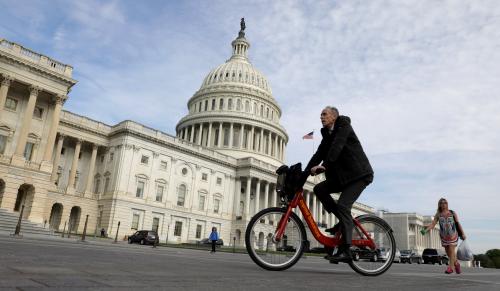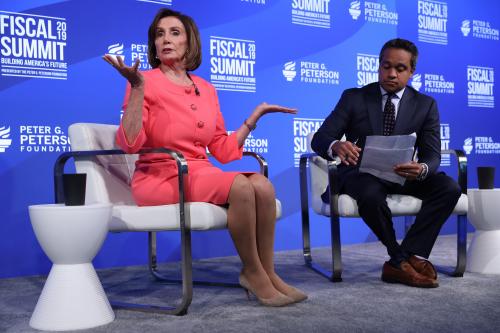The Congressional Budget Office’s (CBO’s) latest federal budget projections (CBO 2019b), released in August, contain two major changes from their previous projections, which were issued in May (CBO 2019a). First, the new projections incorporate the effects of the Bipartisan Budget Act of 2019 (BBA19), which substantially raised discretionary spending (as it is defined in CBO’s current-law baseline).1 Second, CBO sharply lowered its interest rate projections, which reduces future net interest payments on any given debt level.2
This note updates our previous projections of the federal budget outlook and the fiscal gap (as shown in Auerbach, Gale, and Krupkin (AGK) 2019), given CBO’s new projections. We report results under both the current-law baseline that CBO follows, as well as a current-policy baseline that we develop. Unlike the current-law baseline, our current-policy baseline assumes that temporary tax provisions are extended and that tax provisions that have been postponed twice or more are eliminated. In the current-law baseline, discretionary spending rises with inflation after the provisions of the BBA19 end in 2021. The current-policy baseline adjusts non-defense discretionary outlays to rise with the rate of population growth as well with inflation.
Our major result is that the combination of BBA19 and lower interest rate projections reduces the 10-year debt and the long-term fiscal gap under current policy. The reason is that the current-policy baseline we developed based on the May projections (Auerbach, Gale, Krupkin 2019) already incorporated a spending adjustment that was quite close to the changes in BBA 19. As a result, the change in interest rate projections dominates the change in long-term budget projections under the current-policy baseline.
Figure 1 shows primary deficits (which exclude interest payments) for the next 10-years under current law and current policy in previous and current CBO projections. Under the May projections, the current-law primary deficit averaged 1.7 percent of GDP over the next decade, falling from around 2.4 percent of GDP in 2019 to around 1.3 percent of GDP in 2029. In the August projections, primary deficits are higher—averaging 2.5 percent of GDP over the same period—and follow roughly the same time path. The majority of the difference is due to BBA19. In 2029, relative to the May projections, the August projections show a primary deficit that is $182 billion higher under current law.

In contrast, under current policy, the 2029 primary deficit projection fell by $43 billion from May to August (Appendix Table 1). Under both the May and August projections, current policy deficits start rising around 2025 (when the temporary provisions of the 2017 tax cut are assumed to be extended) to a peak of about 3.4 percent of GDP in 2028.3
Figure 2 shows unified deficits over the next decade under the two scenarios. The current-law deficits rise because the increase in discretionary spending outweighs the decline in interest payments. But current policy deficits actually fall, because—as noted above, something similar to BBA19 was already built into the May projections, so that the major change from May to August is the reduction in interest rates.4 By 2029, the unified deficit is higher by $68 billion under current law, but lower by $230 billion under current policy.

Moving to longer-term horizons, Table 1 shows the estimated fiscal gap under current policy in the two projections. The fiscal gap is the size of the immediate and permanent policy change—tax increases or non-interest spending cuts—needed to attain a given debt-to-GDP ratio by a certain date.
| Table 1 2049 Fiscal Gap for Selected Assumptions |
||
| May | August | |
| Central Estimate | ||
| Current Policy Baseline* | 3.9 | 3.59 |
| Alternative Options (Individual Incremental Effects Relative to Current Policy Baseline) | ||
| Current Law for the First Ten Years | -1.92 | -1.24 |
| Start in 2021 | 0.25 | 0.22 |
| Start in 2025 | 0.91 | 0.77 |
| CMS Illustrative Alternative Health Spending | 0.15 | 0.16 |
| CBO Extended Baseline Health Spending | 0.37 | 0.39 |
| NDDS and Other Mandatory Grows with Inflation and Population, Defense Grows with Inflation | -0.54 | -0.6 |
| Income Tax Grows with Bracket Creep and Retirement Withdrawals | -0.3 | -0.31 |
| Low Interest Rates | -0.71 | -0.42 |
Source: Author’s calculations
*Uses current policy for the first ten years and Boards of Trustees (2019) for Medicare.
Table 1 shows that the fiscal gap—with policy changes initiating in 2021—through 2049 has fallen from 3.90 percent of GDP in May to 3.59 percent under the August projections. Most of the sensitivity runs yield very similar results under the May and August projections, with two exceptions. First, the benefit of sticking to the current-law baseline falls (it reduces the fiscal gap by 1.24 percent of GDP under the current projections compared to 1.92 percent of GDP in the earlier projections) because the current-law baseline in August includes significantly more spending now than in the previous projections because of BBA19. Second, the reduction in the fiscal gap due to an alternative assumption that interest rates remain constant at their current levels over the next 30 years are smaller than before because the August baseline reduced the interest rate projections in the baseline.
It is also important to note that the reduction in the fiscal gap under the new projections, largely due to lower interest rates, evaporates as one lengthens the period over which the gap is calculated, from 0.31 percent of GDP through 2049 (3.59 vs. 3.90) to 0.13 percent through 2074 (5.13 vs. 5.26) to zero over the infinite horizon (6.29 in both cases). The reason for this decline is that low interest rates reduce the cost of servicing existing debt, but raise the cost of accumulating the funds needed to cover large future primary imbalances. The latter become relatively more important as a source of the fiscal gap as the period over which the gap is calculated rises. Over the infinite horizon, the benefits and costs of lower interest rates just happen to balance in our projections.
The long-term budget outlook remains problematic, but the recent Bipartisan Budget Act of 2019 did not do much to make the outlook worse. It was, rather, a continuation of what Congress has been doing in the past, a “business as usual” act that does not change the current-policy outlook very much. The reduction in interest rates is good news for fiscal policy, at least in the short run, but it does not solve the problem.
|
Appendix Table 1 Primary Deficit Projections, 2019 – 2029 |
||||||||
| May | August | |||||||
| Current Law | Current Policy | Current Law | Current Policy | |||||
| Primary Deficit ($B) | Primary Deficit (% GDP) | Primary Deficit ($B) | Primary Deficit (% GDP) | Primary Deficit ($B) | Primary Deficit (% GDP) | Primary Deficit ($B) | Primary Deficit (% GDP) | |
| 2019 | 515 | 2.42 | 515 | 2.42 | 588 | 2.78 | 589 | 2.78 |
| 2020 | 436 | 1.97 | 561 | 2.54 | 617 | 2.80 | 641 | 2.91 |
| 2021 | 445 | 1.94 | 631 | 2.75 | 616 | 2.69 | 650 | 2.84 |
| 2022 | 539 | 2.27 | 763 | 3.21 | 702 | 2.96 | 752 | 3.17 |
| 2023 | 487 | 1.97 | 751 | 3.04 | 675 | 2.74 | 752 | 3.05 |
| 2024 | 389 | 1.52 | 685 | 2.67 | 597 | 2.34 | 696 | 2.73 |
| 2025 | 468 | 1.75 | 798 | 3.00 | 682 | 2.57 | 808 | 3.05 |
| 2026 | 411 | 1.48 | 853 | 3.08 | 622 | 2.26 | 854 | 3.10 |
| 2027 | 345 | 1.20 | 972 | 3.38 | 556 | 1.95 | 968 | 3.39 |
| 2028 | 529 | 1.77 | 1188 | 3.98 | 721 | 2.43 | 1160 | 3.91 |
| 2029 | 389 | 1.25 | 1083 | 3.49 | 571 | 1.85 | 1040 | 3.37 |
| Total | 4952 | 1.74 | 8799 | 3.09 | 6948 | 2.45 | 8910 | 3.15 |
|
Appendix Table 2 Unified Deficit Projections, 2019 – 2029 |
||||||||
| May | August | |||||||
| Current Law | Current Policy | Current Law | Current Policy | |||||
| Unified Deficit ($B) | Unified Deficit (% GDP) | Unified Deficit ($B) | Unified Deficit (% GDP | Unified Deficit ($B) | Unified Deficit (% GDP) | Unified Deficit ($B) | Unified Deficit (% GDP) | |
| 2019 | 896 | 4.22 | 898 | 4.22 | 960 | 4.54 | 960 | 4.54 |
| 2020 | 892 | 4.03 | 1018 | 4.60 | 1008 | 4.58 | 1031 | 4.68 |
| 2021 | 962 | 4.19 | 1155 | 5.03 | 1034 | 4.52 | 1069 | 4.67 |
| 2022 | 1116 | 4.69 | 1355 | 5.70 | 1159 | 4.88 | 1211 | 5.10 |
| 2023 | 1122 | 4.55 | 1409 | 5.71 | 1181 | 4.80 | 1262 | 5.13 |
| 2024 | 1071 | 4.18 | 1399 | 5.46 | 1151 | 4.51 | 1256 | 4.92 |
| 2025 | 1189 | 4.46 | 1563 | 5.86 | 1284 | 4.84 | 1420 | 5.36 |
| 2026 | 1179 | 4.26 | 1678 | 6.06 | 1274 | 4.63 | 1521 | 5.53 |
| 2027 | 1162 | 4.04 | 1865 | 6.49 | 1260 | 4.41 | 1697 | 5.94 |
| 2028 | 1399 | 4.68 | 2158 | 7.22 | 1479 | 4.98 | 1959 | 6.59 |
| 2029 | 1310 | 4.22 | 2130 | 6.89 | 1378 | 4.47 | 1900 | 6.16 |
| Total | 12296 | 4.32 | 16626 | 5.85 | 13168 | 4.65 | 15283 | 5.40 |
Alan J. Auerbach is Robert D. Burch Professor of Economics and Law and Director, Robert D. Burch Center for Tax Policy and Public Finance, University of California, Berkeley, and Research Associate, National Bureau of Economic Research. William G. Gale is Arjay and Frances Fearing Miller Chair, Brookings, and Codirector, Urban-Brookings Tax Policy Center. The authors thank Grace Enda and Claire Haldeman for research assistance, and Richard Kogan for his interest rate matrix. All opinions and any mistakes are those of the authors and should not be attributed to the staff, officers, or trustees of any of the institutions with which they are affiliated. The authors did not receive financial support from any firm or person for this article or from any firm or person with a financial or political interest in this article. Neither is currently an officer, director, or board member of any organization with a financial or political interest in this article.







